After many delays, Artemis I lifted off from Launch Complex 39B at Kennedy Space Center in Florida at 1:47 a.m. EST on November 16, 2022. For what happened next, read this post.
Go for launch
Despite Hurricane Nicole blowing through Florida a week ago, the launch of Artemis – our human return to the moon – is still on. NASA said early on Monday, November 14 that conditions remain 90% favorable for the Artemis I launch based on the most recent forecasts for Kennedy Space Center in Florida. Then, Monday afternoon, NASA’s Mission Management Team met and gave the go for launch at 1:04 a.m. ET (6:04 UTC) Wednesday, November 16, 2022, with a two-hour launch window.
Looks like a late night for some of us on Tuesday! It will be a spectacular light show as Artemis 1 blasts off into the midnight sky.
NASA is still targeting launch of Artemis 1 for 1:04 a.m. EST on Wednesday. Listen to the news briefing: https://t.co/dxNwIog3g7
— Spaceflight Now (@SpaceflightNow) November 14, 2022
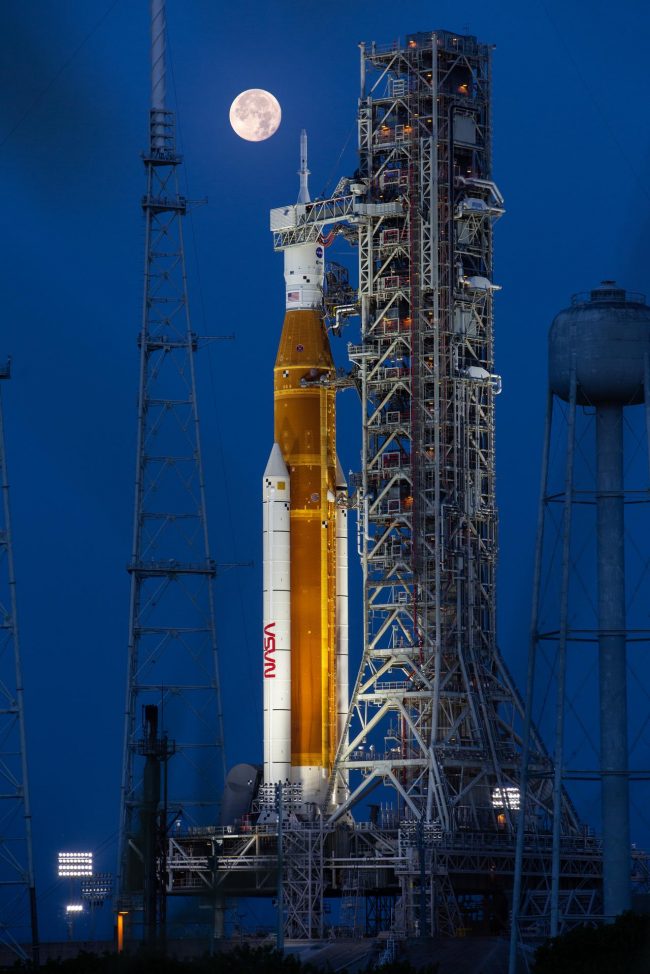
#Artemis I is launching to the Moon!
Nov. 15:
3:30pm ET (2030 UTC): Tanking coverage
10:30pm ET (0330 UTC): Launch broadcastNov. 16:
8:30am ET (1330 UTC): Trajectory burn
10am ET (1500 UTC): Earth views from @NASA_OrionStay tuned: https://t.co/sQWu67xTPq pic.twitter.com/srAEMfTQ63
— NASA (@NASA) November 14, 2022
The Artemis 1 story so far …
In case you haven’t been following it … Artemis 1 is the first of three missions planned to send humans back to the moon by the middle of this decade. It’s exciting … and difficult. Artemis 1 has all the dazzle of the earlier race to the moon in the 1960s … a giant rocket, with powerful thrust and an unmatched element of daring. It’s a big undertaking, and there have been many delays so far.
Of course, spaceflight fans have been disappointed by the many delays. But the upset was often tempered with good humor. And, as NASA officials said on September 3:
We won’t launch until we’re ready.
2 open technical items
NASA’s Artemis blog reported two open technical items as of Monday, November 14:
Engineers examined detailed analysis of caulk on a seam between an ogive on Orion’s launch abort system and the crew module adapter and potential risks if it were to detach during launch. The mission management team determined there is a low likelihood that if additional material tears off it would pose a critical risk to the flight.
Technicians also completed replacing a component of an electrical connector on the hydrogen tail service mast umbilical. While swapping the component did not fully fix the issue, engineers have redundant sources of information supplied through the connector.
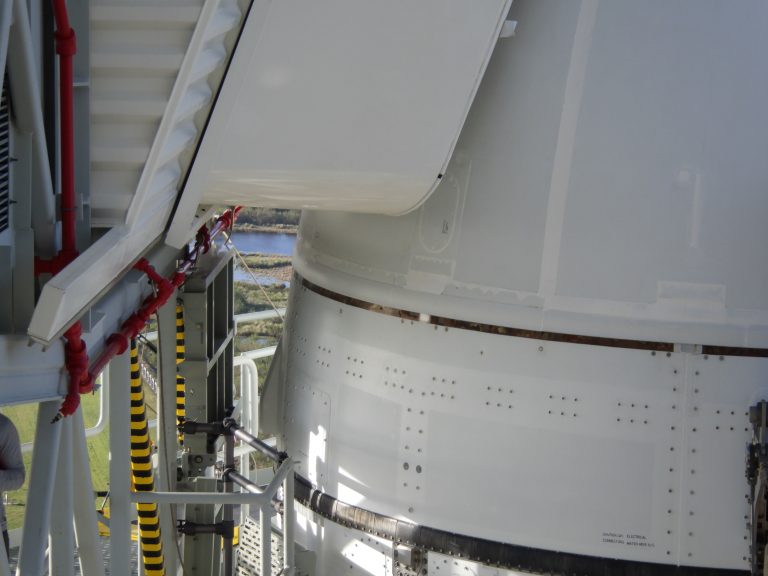
First Ian, then Nicole
NASA most recently rolled Artemis back out to Launchpad 39B at Kennedy Space Center in Florida on November 4, 2022. It had been sheltering there since Hurricane Ian hit Florida in September. Then – too late to roll the mighy moonship back to the Vehicle Assembly Building – Hurricane Nicole blew in, making landfall not far from Kennedy Space Center, on Florida’s Atlantic coast, on November 10. Artemis rode out the storm on the launch pad. On Friday, November 11, assessing the impacts of Nicole, NASA held a press briefing said:
Nothing is stopping us from getting to the 16th.
Now the uncrewed launch is scheduled for November 16, and holding steady so far.
What Artemis 1 will do
Artemis 1’s objective is partly to test NASA’s Space Launch System – aka SLS – a vehicle comparable to the great Saturn V that carried the first astronauts to the moon in the Apollo program of the ’60s and ’70s.
SLS is far more advanced than the Saturn V, technologically. But its main purpose is thrust. SLS will produce 8.8 million pounds (3.9 million kg) of thrust during liftoff and ascent, 15% more than the Saturn V. It’ll need that much thrust to loft a vehicle weighing nearly 6 million pounds (2.7 million kg) to orbit. Propelled by a pair of five-segment boosters and four RS-25 engines, the rocket will reach the period of greatest atmospheric force within 90 seconds, NASA says. After jettisoning its boosters, service module panels and launch abort system, the core stage engines will shut down. At that point, the core stage will separate from the Orion spacecraft.
The Orion moonship is known officially as the Orion Multi-Purpose Crew Vehicle or Orion MPCV. It’ll go to Earth orbit atop SLS following launch. There, it’ll deploy its solar arrays and the Interim Cryogenic Propulsion Stage (ICPS) that’ll give the craft the big push needed to leave Earth’s orbit and travel toward the moon.
Not Orion’s first voyage
Orion already underwent an Earth-orbiting test in 2014, so this isn’t its first voyage to space. But it is its first trip to the moon, and it’ll get there via propulsion by a service module provided by the European Space Agency. The service module will supply the spacecraft’s main propulsion system and power (as well as house air and water for astronauts on future missions).
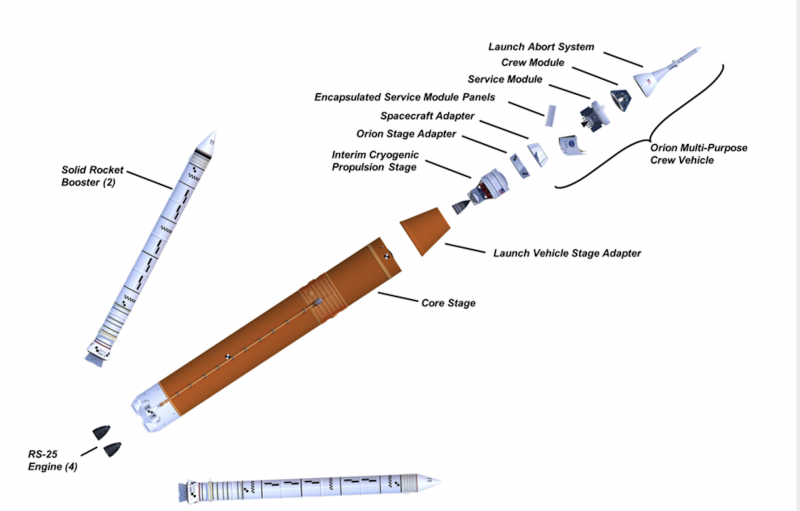
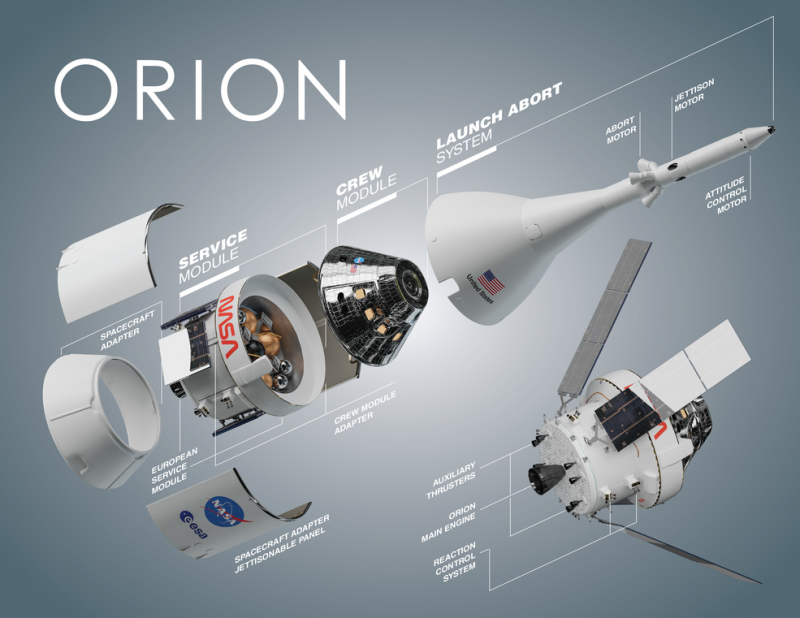
Orion’s mission
Orion will fly as close to the moon’s surface as about 62 miles (100 km). It’ll use the moon’s gravity to propel itself into an orbit about 40,000 miles (70,000 km) from the moon.
The spacecraft will stay in that orbit for about six days, collecting data. During that time, mission controllers will assess its performance. Then it’ll perform a second close flyby of the moon, coming within about 60 miles (100 km). Another precisely timed engine firing of the European-provided service module – in combination with the moon’s gravity – will accelerate the moonship back toward Earth. It’ll enter our planet’s atmosphere traveling at 25,000 mph (11 km/second), producing temperatures of approximately 5,000 degrees Fahrenheit (2,760 degrees Celsius). So it’ll go faster – and get hotter – than during its 2014 flight test.
In all, the mission will last about a month and travel a distance of 1.3 million miles. It’s expected to make a precision landing within eyesight of the recovery ship off the coast of San Diego, California.
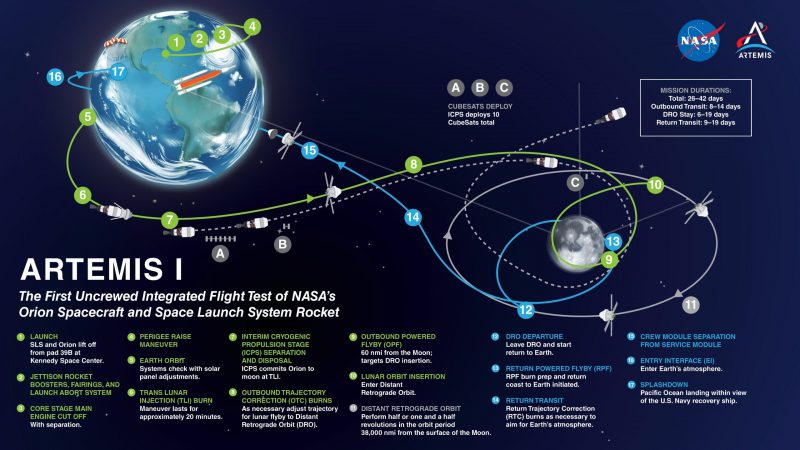
What’s in the crew capsule?
The Orion moonship won’t have a human crew during Artemis 1. Instead, a mannequin dressed in a bright orange spacesuit known as the Orion Crew Survival System will occupy the commander’s seat. NASA says the special suit is:
… designed for a custom fit and equipped with technology features to help protect astronauts on launch day, in emergency situations, throughout high-risk parts of missions near the moon, and during the high-speed return to Earth.
In addition, there will be two other “passengers,” two identical mannequin torsos equipped with radiation detectors. The Israel Space Agency and the German Aerospace Center designed this part of the mission. It’s an experiment to test the AstroRad radiation protection vest, which will provide data on radiation levels.
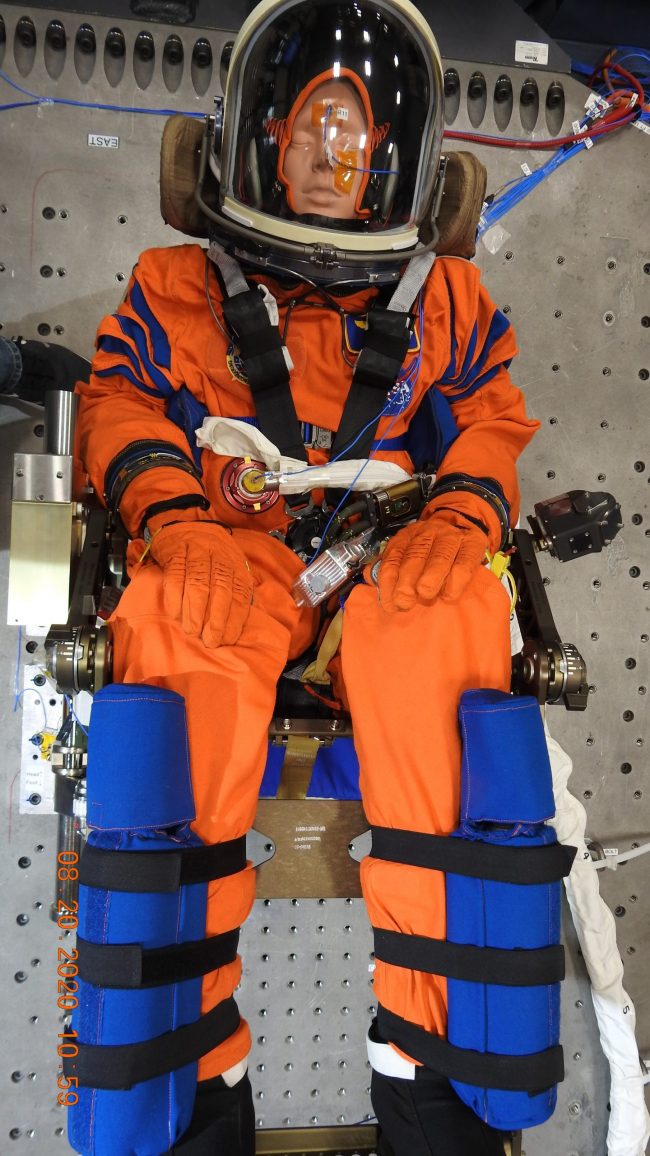
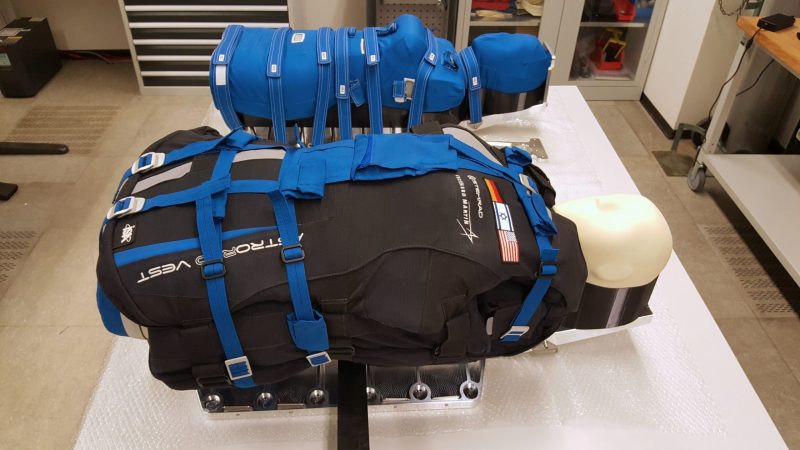
Snoopy will travel on Artemis
Engineers will strap in the mannequin and mannequin torsos. But NASA is also flying a “zero gravity indicator” in the form of a Snoopy cuddly toy, also dressed in an iconic orange NASA jumpsuit. The comic-book character Snoopy was a household name in the 1960s and ’70s, when the Apollo missions were flying. And Apollo 10 astronauts traveled to the moon for a final checkout, prior to the first human moon landing with Apollo 11 on July 20, 1969. Apollo 10 skimmed to within 50,000 feet of the moon’s surface, to “snoop around” (scout the Apollo 11 landing site). So, the crew named its lunar module “Snoopy.”
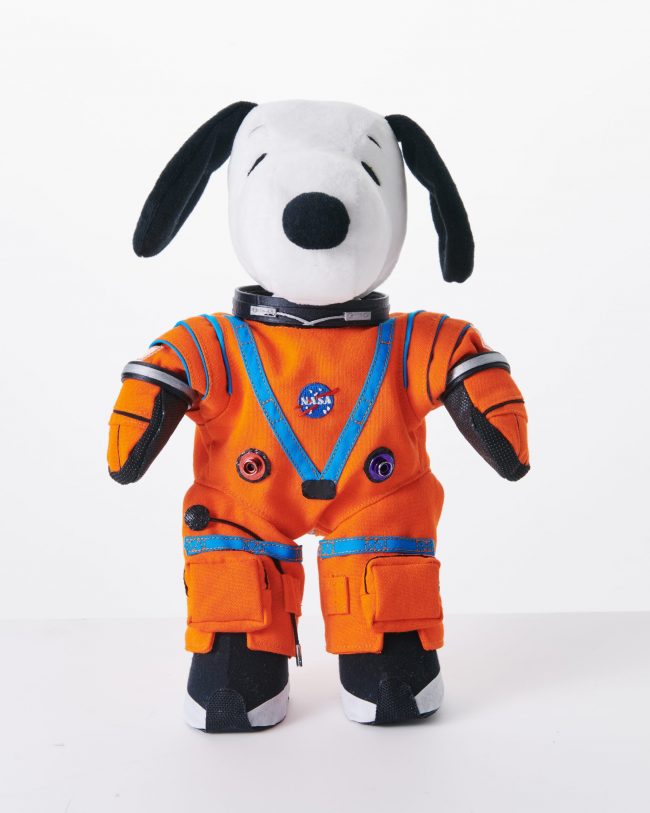
There have been delays
Many earthly spacecraft have visited the moon, but it has been 50 years since humans have walked its surface. And space visionaries have been dreaming for decades of a return to the moon. Although NASA first announced the Artemis program in December 2017, the development of the Orion crew capsule and the powerful SLS began earlier, in 2011. SpacePolicyOnline reported on March 14, 2022:
The first flight of SLS/Orion has been delayed again and again. In 2014, NASA committed to the first launch in November 2018. That slipped to December 2019-June 2020, then to mid-late 2021 and then to 2022. Now, at long last, they are almost ready to take flight.
Read more SLS/Orion history at SpacePolicyOnline, if you’re interested.
A return to the moon
Ultimately, the Artemis program aims to send the first humans back to the moon by the middle of this decade. When they go, they’ll be aiming for the moon’s south pole, a place that scientists have discovered in recent decades has large amounts of water ice. Water contains oxygen, so processing it will make it possible for future astronauts to stay longer.
Someday, visionaries still hope, we will have a permanent presence on the moon. And we will go to Mars.
Such dreams are an integral part of humanity’s natural wanderlust in the 21st century. And so future historians might look back at our time – and at the Artemis missions – as the moment humanity took a true giant leap to space, maybe this time for good.
We are going.
As @NASA prepares to send astronauts to the Moon under #Artemis, we have identified 13 candidate landing regions near the lunar South Pole.
Learn about the landing regions and what sets them apart: https://t.co/XagoqjMi9b pic.twitter.com/lUwJun9yh0
— NASA Artemis (@NASAArtemis) August 19, 2022
Get a visual of what Artemis will be doing
The trajectory for the Artemis mission has been updated by @NASAJPL Horizons following Monday’s cancelled launch. #Artemis is now scheduled to launch on Saturday, Sep 3, and return on Oct. 11. @NASAJPL @NASAArtemis pic.twitter.com/9TgWFzTPjH
— Tony Dunn (@tony873004) August 31, 2022
Bottom line: NASA will attempt to launch the mighty SLS rocket and its attached Orion space capsule on the Artemis 1 mission on November 16, 2022, mission managers confirmed on Monday, November 14.











